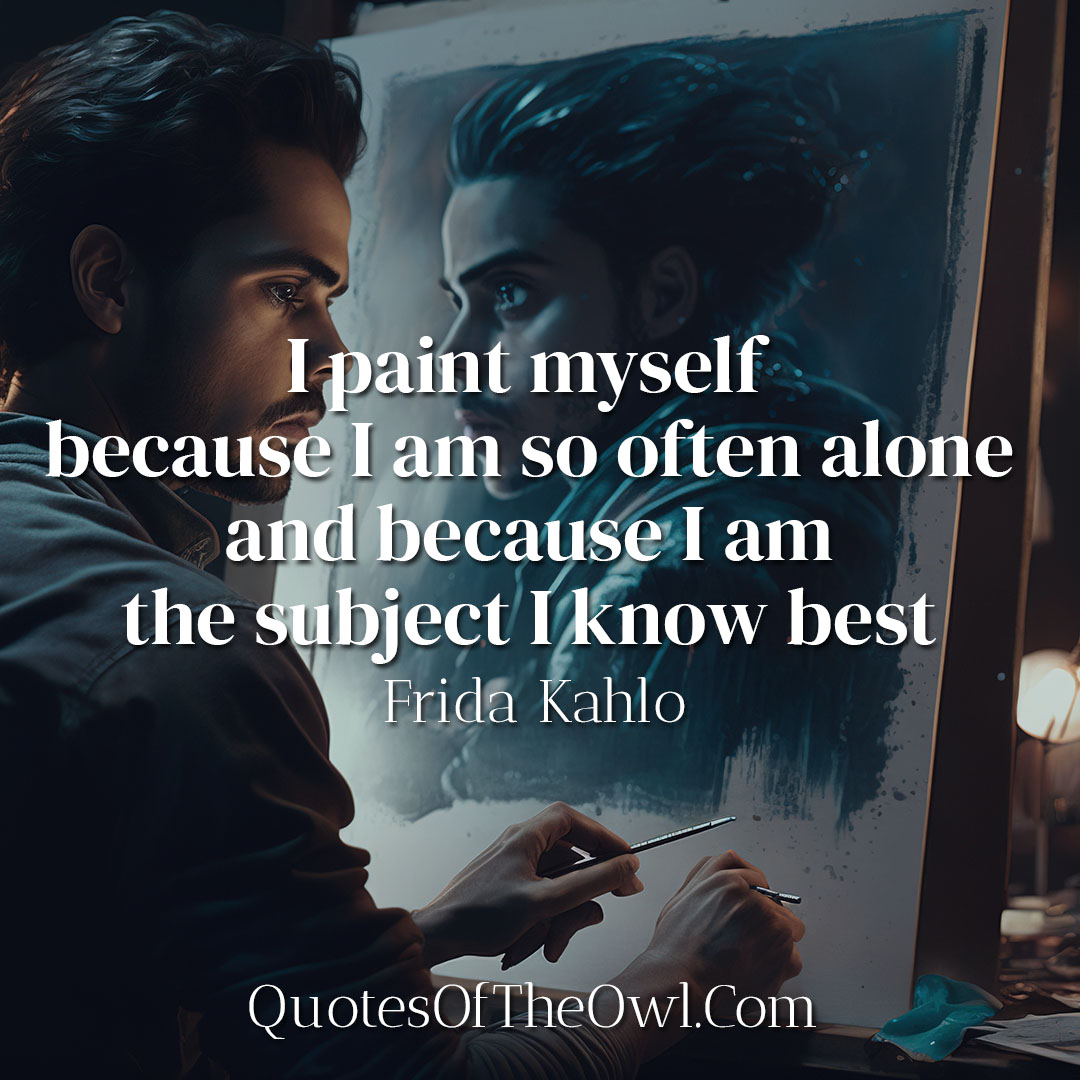I paint myself because I am so often alone and because I am the subject I know best – Frida Kahlo’s Quote Meaning
Frida Kahlo, a renowned Mexican artist, once said, “I paint myself because I am so often alone and because I am the subject I know best.” This quote, filled with introspection and vulnerability, provides a glimpse into the motivations behind Kahlo’s extraordinary body of work. In this article, we will delve into the deeper meaning of this quote and explore how it relates to Kahlo’s life, art, and the universal themes she portrayed.
Understanding Frida Kahlo’s quote
Frida Kahlo’s quote speaks to her profound connection with self-portraiture. Through painting herself, Kahlo found solace in her solitude and embraced the opportunity to delve into her own psyche. By capturing her own image, she had complete control over the subject matter, enabling her to convey her emotions, struggles, and experiences with authenticity and intimacy.
Exploring Frida Kahlo’s life and art
To understand the significance of Kahlo’s quote, we must first delve into her fascinating life and the artistic journey that shaped her unique style. Born in 1907 in Mexico City, Frida Kahlo faced numerous challenges throughout her life, both physical and emotional.
Early life and physical challenges
Kahlo’s early life was marred by illness and physical ailments. At the age of six, she contracted polio, which left her with a weakened right leg. Additionally, at the age of eighteen, Kahlo was involved in a tragic bus accident that caused lifelong pain and numerous surgeries. These physical challenges deeply influenced her art and contributed to her need for self-expression.
Relationships and love life
Another crucial aspect of Kahlo’s life was her relationships, particularly her turbulent marriage to the renowned Mexican artist Diego Rivera. Their relationship was characterized by both passion and turmoil, and it served as a significant source of inspiration and pain for Kahlo. The exploration of love, loss, and longing often found its way onto her canvases, making her art deeply personal and relatable.
Artistic journey and style
Kahlo’s artistic journey was marked by a unique blend of surrealism, symbolism, and realism. Her paintings often incorporated elements of Mexican folk art, depicting vibrant colors, intricate patterns, and cultural symbolism. Through her art, Kahlo communicated her experiences as a woman, a Mexican, and a person living with physical and emotional pain.
Embrace Frida Kahlo’s iconic style with our stunning collection of Frida-inspired t-shirts
Experience the vibrant soul of Frida Kahlo through her mesmerizing wall art collection
Self-portraiture as a form of self-expression
Kahlo’s quote sheds light on the significance of self-portraiture as a means of self-expression. Through painting herself, she was able to transcend the boundaries of societal norms and challenge traditional notions of beauty and identity. Here are some key aspects of self-portraiture in Kahlo’s work:
Capturing emotions and personal experiences
By portraying herself in various emotional states, Kahlo offered a raw and unfiltered glimpse into her inner world. Her art became a conduit for conveying her pain, joy, longing, and resilience. Each brushstroke on the canvas became a testament to her emotional journey, inviting viewers to connect with their own experiences.
Examining identity and self-identity
Kahlo’s self-portraits were not merely representations of her physical appearance but also explorations of her identity. She confronted themes of gender, ethnicity, and cultural heritage, challenging societal constructs and asserting her own sense of self. Her art celebrated individuality and encouraged others to embrace their own unique identities.
Empowering oneself through art
For Kahlo, self-portraiture was a means of empowerment. By painting herself, she reclaimed her agency and transformed her pain into beauty. Through her art, she defied societal expectations and advocated for self-acceptance and self-love. Her unapologetic self-portraits continue to inspire countless individuals to find strength and resilience in their own journeys.
The significance of solitude in Frida Kahlo’s paintings
In her quote, Kahlo acknowledges her solitude as a driving force behind her self-portraits. Solitude played a pivotal role in shaping her artistic expression, allowing her to explore her innermost thoughts and emotions. Here are some key aspects of solitude in Kahlo’s paintings:
Isolation and introspection
Kahlo’s physical and emotional challenges often led to periods of isolation. During these moments, she turned inward, using art as a medium for introspection. By immersing herself in solitude, she found the space and clarity necessary to delve into her deepest thoughts and emotions.
Confronting inner struggles
Through her self-portraits, Kahlo confronted her inner struggles head-on. She fearlessly depicted her physical pain, heartache, and psychological turmoil, refusing to shy away from the complexities of her existence. By acknowledging and expressing her struggles, she found solace and a means of catharsis.
Seeking solace and self-reflection
Solitude provided Kahlo with a sanctuary where she could seek solace and engage in self-reflection. It offered her the freedom to explore her own identity, question societal norms, and reconcile with her past. Within the quietude of her studio, she found a safe haven to confront her demons and emerge stronger.
The universal appeal of Frida Kahlo’s art
While deeply personal, Frida Kahlo’s art resonates with audiences worldwide due to its universal themes and emotions. Her self-portraits transcend time and cultural barriers, touching the hearts of people from diverse backgrounds. Here are some reasons why Kahlo’s art has a universal appeal:
Connecting with the human experience
Through her vulnerability and honesty, Kahlo’s art speaks to the shared human experience. The themes of love, pain, loss, and resilience depicted in her paintings are emotions that resonate with people across cultures and generations. In connecting with Kahlo’s art, viewers find solace in the realization that their own experiences are not isolated.
Embracing vulnerability and authenticity
Kahlo’s willingness to expose her vulnerabilities and embrace her imperfections is a testament to the power of authenticity. Her art encourages individuals to embrace their own vulnerabilities, celebrating their unique stories and experiences. By doing so, she inspires others to live their lives authentically and unapologetically.
Inspiring others through personal narratives
Kahlo’s art goes beyond self-expression; it serves as a source of inspiration and empowerment. Her paintings embody a narrative of resilience, self-acceptance, and the triumph of the human spirit. By sharing her personal journey, Kahlo encourages others to find their own voice, to confront their challenges, and to create their own narratives of strength and perseverance.
Conclusion
Frida Kahlo’s quote, “I paint myself because I am so often alone and because I am the subject I know best,” offers a profound insight into the motivations behind her remarkable body of work. Through self-portraiture, Kahlo found a means of self-expression, empowerment, and connection with others. Her art continues to captivate audiences worldwide, transcending time and cultural boundaries. Kahlo’s ability to navigate solitude and channel her experiences into her art serves as a testament to the transformative power of creativity.
Explore the wisdom and inspiration of Frida Kahlo through her powerful quotes!

